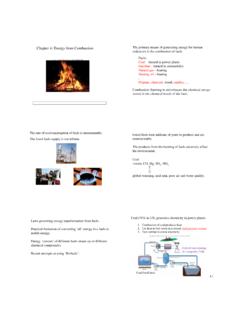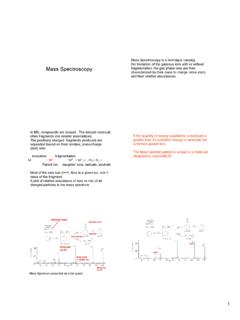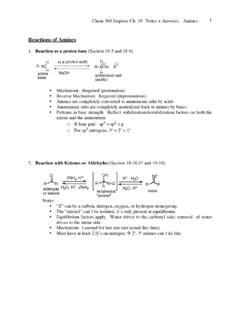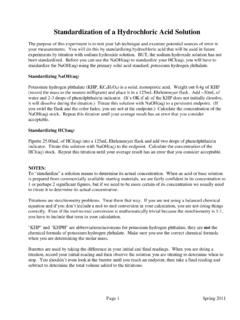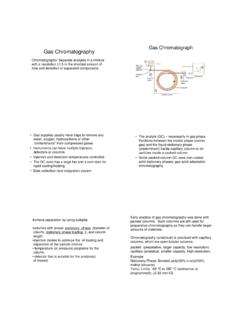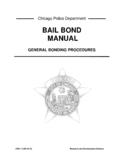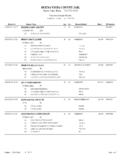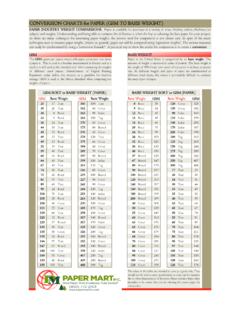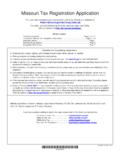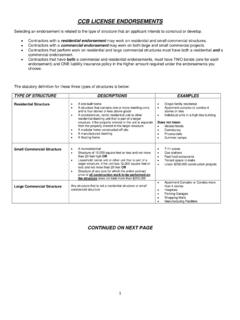Transcription of Review of Organic Chem II - Minnesota State University ...
1 Organic Chemistry II Review Jasperse Basic Mechanism Principles 1 Reaction Mechanisms (see p. 310) A. Recognizing/Classifying as Radical, Cationic, or Anionic 1. Radical initiation requires both energy (either hv or ) and a weak, breakable heteroatom-heteroatom bond o Cl-Cl, Br-Br, O-O (peroxide), N-Br, 2 Guides for That are Usually Reliable: hv radical mechanism peroxides radical mechanism 2. Anionic a strong anion/base appears in the recipe no strong acids should appear in the recipe mechanisms should involve anionic intermediates and reactants, not strongly cationic ones (except for do-nothing spectators like metal cations) The first step in the mechanism will involve the strong anion/base that appears in the recipe 3.
2 Cationic a strong acid/electrophile appears in the recipe no strong anion/base should appear in the recipe mechanisms should involve cationic intermediates and reactants, not strongly anionic ones (except for do-nothing spectators like halide or hydrogen sulfate anions) The first step in the mechanism will involve the acid that appears in the recipe. The last step will often involve a deprotonation step. Often the main step occurs in between the proton-on and proton-off steps B. Miscellaneous Mechanism Tips 1. Keep track of hydrogens on reacting carbons 2. Each step in a mechanism must balance 3. The types of intermediates involved (cation, anion, or radical) should be consistent with the reaction classification above a.
3 If the reaction is cationic, don t show anionic intermediates b. If the reaction is anionic, don t show cationic intermediates 4. Usually conditions are ionic. 5. Use a reactive species, whether strong anion or an acid, to start the first step a. If acidic, first step will involve protonation of the Organic b. If anionic, the first step will involve the anion attacking the Organic . 6. While it isn t always easy to figure out what is a good mechanism, you should often be able to eliminate an unreasonable mechanism. Organic Chemistry II Review Jasperse Basic Mechanism Principles 2 Some Arrow-Pushing Guidelines (Section ) 1. Arrows follow electron movement. 2. Some rules for the appearance of arrows The arrow must begin from the electron source.
4 There are two sources: a. An atom (which must have a lone pair to give) b. A bond pair (an old bond that breaks) An arrow must always point directly to an atom, because when electrons move, they always go to some new atom. 3. Ignore any Spectator Atoms. Any metal atom is always a spectator When you have a metal spectator atom, realize that the non-metal next to it must have negative charge 4. Draw all H s on any Atom Whose Bonding Changes 5. Draw all lone-pairs on any Atom whose bonding changes 6. KEY ON bond CHANGES. Any two-electron bond that changes (either made or broken) must have an arrow to illustrate: where it came from (new bond made) or an arrow showing where it goes to (old bond broken) 7.
5 Watch for Formal Charges and Changes in Formal Charge If an atom s charge gets more positive it s donating/losing an electron pair arrow must emanate from that atom or one of it s associated bonds. There are two more positive transactions: When an anion becomes neutral. In this case, an arrow will emanate from the atom. The atom has donated a lone pair which becomes a bond pair. When a neutral atom becomes cationic. In this case, the atom will be losing a bond pair, so the arrow should emanate from the bond rather than from the atom. If an atom s charge gets more negative it s accepting an electron pair an arrow must point to that atom.
6 Ordinarily the arrow will have started from a bond and will point to the atom. 8. When bonds change, but Formal Charge Doesn t Change, A Substitution is Involved Often an atom gives up an old bond and replaces it with a new bond . This is substitution . In this case, there will be an incoming arrow pointing directly at the atom (to illustrate formation of the new bond ), and an outgoing arrow emanating from the old bond that breaks Organic Chemistry II Review Jasperse Some Fundamental Stability/Reactivity Principles 1 Reactive Intermediates: Stability Patterns Shortlived, unstable, highly reactive intermediates Normally lack normal bonding These are tremendously important: 1.
7 They will be the least stable intermediate in any multistep mechanism 2. When formed, they are products of the rate-determining step 3. Factors that stabilize them will speed up reaction rates Thus it is very important to know their stability patterns! Class Structure Stability Pattern Carbocations Allylic > 3 > 2 > 1 > methyl > alkenyl (vinyl, aryl) Electron Poor Electrophilic/ Acidic Carbon Radicals Allylic > 3 > 2 > 1 > methyl > alkenyl (vinyl, aryl) Electron Poor Electrophilic/ Acidic Carbanions Allylic > alkenyl (vinyl, aryl) > methyl > 1 > 2 > 3 Electron Rich Nucleophilic/ Basic Notes 1. Both carbocations and radicals have the same pattern. So you don t need to memorize them twice!
8 2. Carbanions are almost exactly the reverse, except that being allylic is ideal for both. 3. All benefit from resonance (allylic). 4. Cations and radicals both fall short of octet rule. As a result, they are both electron deficient. Carbanions, by contrast, are electron rich. 5. Alkyl substituents are electron donors. As a result, they are good for electron deficient cations and radicals (3 > 2 > 1 > methyl) but bad for carbanions. 6. Alkenyl (vinyl or aryl) carbons are inherently a bit electron poor. This is excellent for carbanions, but terrible for cations or radicals. CCCO rganic Chemistry II Review Jasperse Some Fundamental Stability/Reactivity Principles 2 Stability/Reactivity/Selectivity Principles 1.
9 Reactant Stability/Reactivity: The more stable the reactant, the less reactive it will be. In terms of rates, this means that the more stable the reactant, the slower it will react. (The concept here is that the more stable the reactant, the more content it is to stay as is, and the less motivated it is to react and change into something different) Key note: Often the reactant that s relevant in this context will not be the original reactant of the reaction, but will be the reactant involved in the rate determining step. Basicity Why: As anion stability increases from A to D, the reactivity decreases Nucleophilicity Why: As anion stability increases from A to D, the reactivity decreases Nucleophilicity Why: As anion stability increases from A to D, the reactivity decreases Reactivity toward alkanes via radical halogenation F2 > Cl2 > Br2 > I2 because F > Cl > Br > I Why: Chlorine is more reactive the bromine because chlorine radical is less stable then bromine radical.
10 Electrophilicity (Reactivity in SN2, SN1, E2, E1 Reactions) Why: As carbon-halogen bond stability increases, the reactivity decreases CH2 NaNHNaONaONaO>>>ABCDCH2 NaNHNaONaONaO>>>ABCDSeNaSNaONaONaO>>>ABC DIBrCl>> Organic Chemistry II Review Jasperse Some Fundamental Stability/Reactivity Principles 3 2. Product Stability/Reactivity: The more stable the product, the more favorable its formation will be. In terms of rates, this means that the more stable the product, the faster the reaction. (The concept here is that the more stable the product, the more favorable it will be to make that product.) Key note: Often the product that s relevant in this context will not be the final product of the reaction, but will be the product of the rate determining step.
